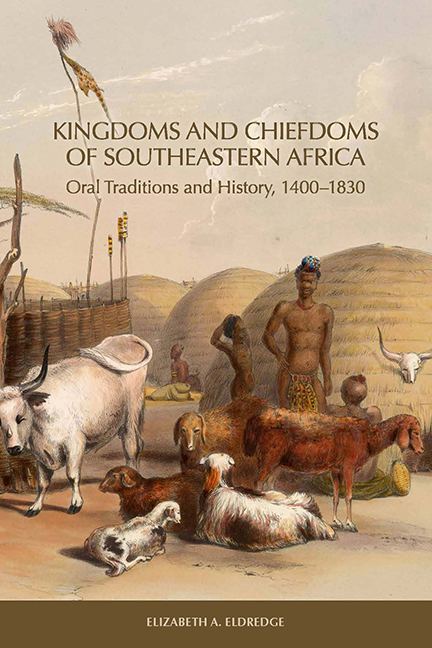Book contents
- Frontmatter
- Contents
- List of Illustrations
- Preface
- 1 History and Oral Traditions in Southeastern Africa
- 2 Oral Traditions in the Reconstruction of Southern African History
- 3 Shipwreck Survivor Accounts from the Sixteenth and Seventeenth Centuries
- 4 Founding Families and Chiefdoms East of the Drakensberg
- 5 Maputo Bay Peoples and Chiefdoms before 1740
- 6 Maputo Bay, 1740–1820
- 7 Eastern Chiefdoms of Southern Africa, 1740–1815
- 8 Zulu Conquests and the Consolidation of Power, 1815–21
- 9 Military Campaigns, Migrations, and Political Reconfiguration
- 10 Ancestors, Descent Lines, and Chiefdoms West of the Drakensberg before 1820
- 11 The Caledon River Valley and the BaSotho of Moshoeshoe, 1821–33
- 12 The Expansion of the European Presence at Maputo Bay, 1821–33
- 13 Southern African Kingdoms on the Eve of Colonization
- Appendix A Ama Swazi King Lists
- Appendix B Chronology of Conflicts, Migrations, and Political Reconfiguration East of the Drakensberg in the Era of Shaka
- Appendix C Interviewees from the James Stuart Collection of Oral Traditions
- Notes
- Bibliography
- Index
11 - The Caledon River Valley and the BaSotho of Moshoeshoe, 1821–33
Published online by Cambridge University Press: 14 March 2018
- Frontmatter
- Contents
- List of Illustrations
- Preface
- 1 History and Oral Traditions in Southeastern Africa
- 2 Oral Traditions in the Reconstruction of Southern African History
- 3 Shipwreck Survivor Accounts from the Sixteenth and Seventeenth Centuries
- 4 Founding Families and Chiefdoms East of the Drakensberg
- 5 Maputo Bay Peoples and Chiefdoms before 1740
- 6 Maputo Bay, 1740–1820
- 7 Eastern Chiefdoms of Southern Africa, 1740–1815
- 8 Zulu Conquests and the Consolidation of Power, 1815–21
- 9 Military Campaigns, Migrations, and Political Reconfiguration
- 10 Ancestors, Descent Lines, and Chiefdoms West of the Drakensberg before 1820
- 11 The Caledon River Valley and the BaSotho of Moshoeshoe, 1821–33
- 12 The Expansion of the European Presence at Maputo Bay, 1821–33
- 13 Southern African Kingdoms on the Eve of Colonization
- Appendix A Ama Swazi King Lists
- Appendix B Chronology of Conflicts, Migrations, and Political Reconfiguration East of the Drakensberg in the Era of Shaka
- Appendix C Interviewees from the James Stuart Collection of Oral Traditions
- Notes
- Bibliography
- Index
Summary
The first two decades of the nineteenth century had brought multiyear droughts and food scarcity more than once across the region of southeastern Africa. As the ecological stress of drought reemerged in the 1820s, entire populations were faced with food scarcity caused by crop failures and the loss of cattle to poor pasturage. Responses to scarcity and looming famine included raiding for livestock and migration and resettlement at better-watered sites with better cattle posts. The consequent dislocations disrupted not only food production but also social networks and systems of political patronage and authority. Some chiefdoms increased their wealth and authority over others, and some were dispersed and scattered and lost their autonomy and identity as they were incorporated into the stronger chiefdoms.
Moshoeshoe's BaMokoteli and the Rise in Violence before 1822
In the 1810s the BaMokoteli branch of the BaMonaheng were a small chiefdom, living in the northern region of modern Lesotho under a small chief, Mokhachane, putatively subject to the overrule of the related Ba Sekake. Mokhachane's senior son, Moshoeshoe, came of age at the turn of the century, underwent initiation rites in about 1803, and sometime afterward took his age-mates to build their own village at Menkhoaneng. While he was still very young, Moshoeshoe was joined by a man of MaZizi origins named Ntseke, who was from the same descent line as the BaPhuthi chief Mokuoane (father of Moorosi), and Ntseke's son Makoanyane became Moshoeshoe's companion as a youth and later his famous military commander, known to have saved Moshoeshoe's life on at least one occasion before the migration to Thaba Bosiu. After visiting the sage Mohlomi (who died in 1814), according to Moshoeshoe's son Tlali Moshoeshoe,
Moshoeshoe returned. It was at that time that many wars arose. As for all these peoples whose names I have already mentioned, now two who lived in one place would fight with three who lived together. Then all these little nations—although I am unable to mention everybody, for I too have only a limited knowledge—simply scattered throughout the whole land, for everywhere there was fighting, and throughout this time all that one held in one's hands was war. It was only if the herds returned home in the evening that people knew that there was no war.
- Type
- Chapter
- Information
- Kingdoms and Chiefdoms of Southeastern AfricaOral Traditions and History, 1400–1830, pp. 267 - 293Publisher: Boydell & BrewerPrint publication year: 2015

